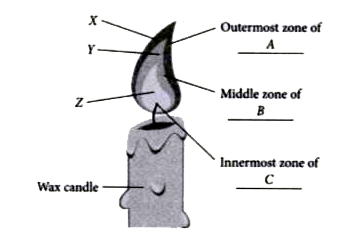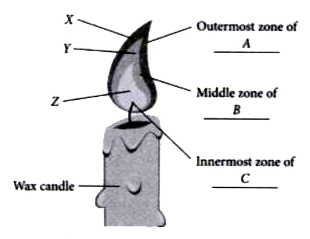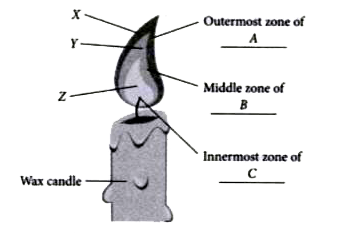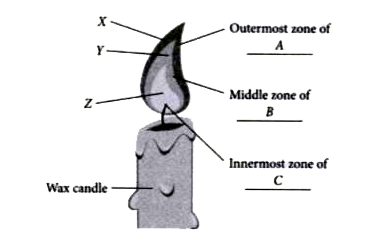The luminous zone of a flame:
consists of unburnt carbon particles
possess maximum temperature
is yellow in colour
is the zone of complete combustion
The correct Answer is:A
Step-by-Step Text Solution
1. Understanding Flame Zones: A flame consists of three distinct zones: the non-luminous zone, the luminous zone, and the dark zone. Each zone has different characteristics based on temperature, color, and combustion efficiency.
2. Identifying the Luminous Zone: The luminous zone is the brightest part of the flame. It is typically located in the middle of the flame when observing a candle flame.
3. Temperature Characteristics: The temperature in the luminous zone is moderately hot. This means that while it is not the hottest part of the flame, it is still capable of producing significant heat.
4. Oxygen Supply: In the luminous zone, there is an insufficient supply of oxygen. This lack of oxygen leads to incomplete combustion of the fuel.
5. Color of the Luminous Zone: The color of the luminous zone is yellow. This yellow color is primarily due to the presence of unburnt carbon particles that glow when heated.
6. Presence of Unburnt Carbon: Due to the insufficient oxygen supply, some carbon particles do not completely combust and remain unburnt, contributing to the yellow color of the luminous zone.
Summary Statement
The luminous zone of a flame is the brightest part of the flame, located in the middle, with a moderately hot temperature. It has an insufficient supply of oxygen, resulting in incomplete combustion and the presence of unburnt carbon particles, which give it a yellow color.
---
The luminous zone of a flame is the brightest part of the flame, located in the middle, with a moderately hot temperature. It has an insufficient supply of oxygen, resulting in incomplete combustion and the presence of unburnt carbon particles, which give it a yellow color.
Topper's Solved these Questions
- COMBUSTION AND FLAME BOOK - S CHAND IIT JEE FOUNDATIONCHAPTER - COMBUSTION AND FLAME EXERCISE - Self Assessment Sheet-17(Fill in the blanks)
22 Videos
- COMBUSTION AND FLAME BOOK - S CHAND IIT JEE FOUNDATIONCHAPTER - COMBUSTION AND FLAME EXERCISE - Question Bank-17(Answer the questions)
10 Videos
- COAL AND PETROLEUMBOOK - S CHAND IIT JEE FOUNDATIONCHAPTER - COAL AND PETROLEUMEXERCISE - Self Assessment Sheet-16
10 Videos
- HYDROGENBOOK - S CHAND IIT JEE FOUNDATIONCHAPTER - HYDROGENEXERCISE - SELF ASSESSMENT SHEET
28 Videos
Similar Questions
Knowledge Check
Which of the following statements are true?
I. In the luminous zone of candle flame, vaporised wax gets oxidised to carbon dioxide which burns with a blue flame.
II. There is no burning in the dark inner zone of the flame.
III. Non luminous zone is the hottest part of the flame.
IV. Luminous zone of a flame is mainly due to incomplete burning of carbon.AI and III onlyBII and III onlyCII, III and IV onlyDAll of theseWhen you introduce a glass plate into the luminous zone of a candle flame for a few seconds, the observation is as shown in figure (b). What does the observation indicate?
 ADeposition of burnt CO2 particles present in the air around the flame.BDeposition of unburnt carbon particles in the luminous zone of the flame.CDeposition of molten wax.DAll of these.
ADeposition of burnt CO2 particles present in the air around the flame.BDeposition of unburnt carbon particles in the luminous zone of the flame.CDeposition of molten wax.DAll of these.A flame is the visible gaseous part of a fire. It is a zone of combustion of gaseous substances accompanied by evolution of heat and light. All substances do not burn with a flame. Only those substances that vaporise during burning produce flame. A candle flame is taken to study the various zones of a flame.

The luminous and non-luminous zones of flame is respectively.AOutermost, middle zoneBInnermost, outermost zoneCMiddle, outermost zoneDOutermost, innermost zone
In order to melt metals such as gold and silver, goldsmiths blow the outermost zone of a flame towards the gold or silver using a metallic blow-pipe.
Why is the outermost zone of the flame blown towards the gold or silver?
View SolutionA flame is the visible gaseous part of a fire. It is a zone of combustion of gaseous substances accompanied by evolution of heat and light. All substances do not burn with a flame. Only those substances that vaporise during burning produce flame. A candle flame is taken to study the various zones of a flame.

Different zones of a candle flame are marked by the letters (A), (B) and (C).
Which of the following statements are correct?
(I) (B) is the hottest part of the flame.
(II) (C) is moderately hot.
(III) (A) is the hottest part of the flame.
(IV) (A) is moderately hot whereas (C) is the coldest part.
(V) (C) is the luminous zone.
(VI) (B) is the luminous zone.
(VII) (A) is the dark zone.
View SolutionA flame is the visible gaseous part of a fire. It is a zone of combustion of gaseous substances accompanied by evolution of heat and light. All substances do not burn with a flame. Only those substances that vaporise during burning produce flame. A candle flame is taken to study the various zones of a flame.

Which zone of a candle flame is the zone of no combustion?
View SolutionA flame is the visible gaseous part of a fire. It is a zone of combustion of gaseous substances accompanied by evolution of heat and light. All substances do not burn with a flame. Only those substances that vaporise during burning produce flame. A candle flame is taken to study the various zones of a flame.

(A), (B) and (C) are respectively.
View SolutionA flame is the visible gaseous part of a fire. It is a zone of combustion of gaseous substances accompanied by evolution of heat and light. All substances do not burn with a flame. Only those substances that vaporise during burning produce flame. A candle flame is taken to study the various zones of a flame.

Arrange X, Y and Z in increasing order of temperature.
View Solution
